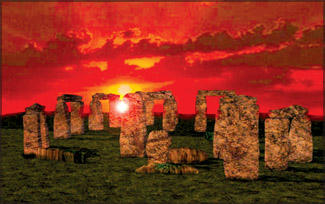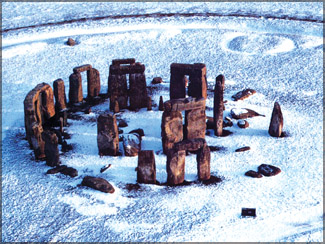
|
Little Blue Birdie's Diary
|
Stonehenge, the mysterious monument
Dear Diary,
I got a little break after my last journal entry. I wonder what the
readers of my journal did during the last weekend and whether they tried
to find more information about the Sphinx. If they had done so, the
details and stories are sure to have fascinated them.
 The
Sphinx belongs to the mysterious monuments category. Another monument
that belongs to this category is Stonehenge in Wiltshire, UK. It is
believed to have been built around 3100 BC, out of stones identified as
bluestone, Sarsen, and Welsh sandstone. The
Sphinx belongs to the mysterious monuments category. Another monument
that belongs to this category is Stonehenge in Wiltshire, UK. It is
believed to have been built around 3100 BC, out of stones identified as
bluestone, Sarsen, and Welsh sandstone.
The people who had lived in the area are thought to have worshipped
Lunar and Solar (the Moon and Sun).
Except on special occasions, visitors are not permitted to walk
amongst the stones. However, being birds, we do not need tickets or any
special permission to enter a place. Legend says Stonehenge was built as
a place to make human sacrifices.
Whatever its origin, it is probably the most important prehistoric
monument in the whole of UK. It has attracted visitors from earliest
times and stands as a timeless monument to the people who built it.
Stonehenge was constructed in three phases and what we see today is
only the final stage. It has been estimated that all three phases of the
construction process would have required more than thirty million hours
of labour.
The first Stonehenge was a large earthen-work, comprising a ditch,
bank and the Aubrey holes, all probably built around 3100 BC. The Aubrey
holes were round pits in the chalk, about one metre wide and deep, with
steep sides and flat bottoms.
 They
formed a circle about 284 feet in diameter. Excavations have revealed
burnt human bones in some of the chalk filling, but the holes themselves
were probably made, not for the purpose of graves, but as part of a
religious ceremony. They
formed a circle about 284 feet in diameter. Excavations have revealed
burnt human bones in some of the chalk filling, but the holes themselves
were probably made, not for the purpose of graves, but as part of a
religious ceremony.
Shortly after the completion of this stage, Stonehenge was abandoned
and left untouched for over a 1000 years. The second and most dramatic
stage of Stonehenge started around 2150 BC.
Some 82 bluestones from the Preseli Mountains, in south-west Wales,
were transported to the site. It is thought that these stones, some
weighing about four tonnes each, were dragged on rollers and sledges to
the headwaters on Milford Haven and then loaded onto rafts.
They were carried by water along the south coast of Wales and up the
rivers Avon and Frome, before being dragged overland again to near
Warminster in Wiltshire. The final stage of the journey was mainly by
water, down the river Wyle to Salisbury, then the Salisbury Avon to west
Amesbury.
The third stage of Stonehenge, carried out around 2000 BC, saw the
arrival of the Sarsen stones, which were almost certainly brought from
the Marlborough Downs near Avebury, in north Wiltshire, about 25 miles
north of Stonehenge.
 The
largest of the Sarsen stones transported to Stonehenge weigh 50 tonnes
and transportation by water would have been impossible; the stones could
only have been moved using sledges and ropes. The
largest of the Sarsen stones transported to Stonehenge weigh 50 tonnes
and transportation by water would have been impossible; the stones could
only have been moved using sledges and ropes.
Modern calculations show that it would have taken 500 men using
leather ropes to pull one stone, with an extra 100 men needed to lay the
huge rollers in front of the sledge. These were arranged in an outer
circle with a continuous line of lintels (type of stone).
The final stage took place soon after 1500 BC when the bluestones
were rearranged in the horseshoe and circle that we see today. The
original number of stones in the bluestone circle was probably around
60; these have long since been removed or broken up. Some remain only as
stumps below ground level.
There is a lot more to see and explore in this wonderful place. But
since it was getting dark, we flew back to our roost and decided to
return some other day. I will be back with more exciting information
about Stonehenge then. Bye! |
